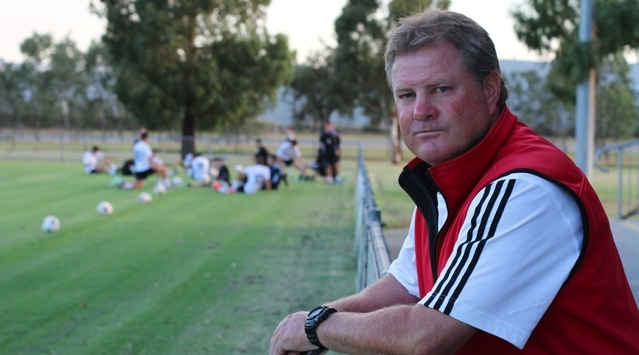He is one of the most distinguished and decorated individuals in Victorian football today, unearthing some of the finest young talents to come out of Australia. Yet for all his pedigree and achievements, Stuart Munro often flies under the radar when it comes to recognition of the state’s best coaches.
The Scotsman’s playing career spanned nearly two decades, underlined by a successful seven year stint with Scottish giants Rangers. A move down under later in his playing career helped launch his coaching career, where he has spent years on the sidelines managing in the NSL, VPL and A-League, gaining a reputation for playing a pivotal role in the development of emerging Australian talent.
The beginning
The 52 year-old’s football journey began on the streets of Falkirk, Scotland, in the late 1960s and early 1970s, where every young kid would play the round ball game. “Back then there were no video games and we’d play football on the streets until a car would pass, before continuing once it drove past,” Munro recalls.
“Once you got to 12 to 13 years of age you would get involved in club football where you worked your way through the ranks, trying to get noticed by scouts at various levels.”
At the age of 16, Munro was signed up by Scottish Premiership side St Mirren, be he lasted just one season in the professional set-up. The experience did not deter the motivated Munro, who returned to the semi-professional leagues and excelled in the two years he spent at club Alloa Athletic. His good form for the club saw the blossoming left-back make a dream-move to Glasgow Rangers in 1984.
Glasgow Rangers
“At the time, Rangers were a massive club who were not fulfilling their full potential up until a year and a half into my stint, before Graeme Souness came in as manager,” Munro says.
The stewardship of Souness, coupled with the appointment of businessman David Holmes as club director, saw the club embark on a period of historical success known as the Rangers Revolution. “The club went from being one which just played on a Saturday, to suddenly being a seven-day institution which brought in so much money as it began to reverse the trend of the best Scottish players going to England,” he says.
“All of a sudden the best English players started crossing the border and at Rangers we were signing players like Terry Butcher the England captain, Three Lions goalkeeper Chris Woods, Ray Wilkins, Trevor Steven and Gary Stevens, at a time when we were one of the biggest clubs in Britain both on the field and in financial terms.”
At the Glasgow giants, Munro was a firm fan favourite given that he was one of the few players in the starting eleven without full representative honours. Eight years in Glasgow saw the unsung hero win four Scottish titles and play his part in many memorable Old Firm derbies against Celtic.
“[They were] incredible in that I’ve never seen anything like it in my whole life, as you could not communicate with players next to you due to the noise of the crowd,” he says. “I played in a number of those games and I was quite fortunate that I came out on the winning side more often than a loss.”
Due to his club’s domestic standing, Munro was also able to test himself against some of Europe’s best teams on the continental stage. “We had some great nights in Europe, playing against the likes of Bayern Munich, Inter Milan and probably the greatest team I ever came up against in Red Star Belgrade, who went on to win the European Cup in 1991,” he says. “We tended to get a lot of teams from the Eastern Bloc, but they were fantastic occasions where the atmosphere was second to none.”
Munro reflects on his time at the Glasgow giants as a “successful period,” where he was an integral member of the Nine-in-a-Row era, playing his part in the first three titles won over the course of those years. A niggling hernia injury saw his time at Rangers come to an end, with new manager Walter Smith dipping into the transfer market, spending just under a million pounds on left back David Robertson. An invitation from former Rangers assistant Don Mackay saw Munro make the move down the border to Blackburn Rovers.
To England and back
The Scotsman’s time in Lancashire proved frustrating and rather uneventful, with Munro making only the solitary league appearance for the club, in a period of his career spent longer on the treatment table than on the pitch. “I had a solid pre-season and injured my ankle ligaments in the last friendly, missing the opening three months of the season, and by the time I returned Don Mackay got the sack and in came Kenny Dalglish,” he says.
“When Kenny came in, he tried to find out what was wrong with me and sent me to get scans where it was realised that I had a broken bone in my ankle.”
By the time Munro underwent an operation, completed rehabilitation and recovered from the injury, Dalglish had signed Alan Wright as the first choice left back. After 18 months at Ewood Park, Munro dropped down a division and signed for Bristol City, where he spent the next four years “thoroughly enjoying my football.” A memorable FA Cup victory over Liverpool at Anfield was the highlight of his spell at Ashton Gate.
Relegation to the third tier saw Munro’s time at City come to an end, moving back to Scotland and hometown club Falkirk where he was appointed as player-coach, followed by a short stint at St Mirren.

